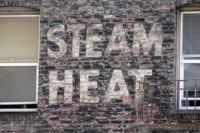 Old boiler rooms are often home to steam-heating boilers. Older cities are loaded with these and lots of people — knuckleheads included — have had decades to mess with what the “dead men” once lovingly installed. So, here’s a short list of things to look for when you’re troubleshooting one of those old systems, starting in the boiler room.
Old boiler rooms are often home to steam-heating boilers. Older cities are loaded with these and lots of people — knuckleheads included — have had decades to mess with what the “dead men” once lovingly installed. So, here’s a short list of things to look for when you’re troubleshooting one of those old systems, starting in the boiler room.Pigtails
A pigtail is a short, curved, and very appropriately named piece of pipe that sits under a gauge or a pressuretrol. Its first job is to fill with water and keep the latent heat of steam from reaching through to the gauge or the pressuretrol. This increases the lifespan of whatever the pigtail is serving.
The pigtail’s other job is to clog. There’s only one way in and out of this thing. Roiling water is under it and a lot of surface debris is flying up into it. Sooner or later, every pigtail clogs. Your time is too valuable to spend cleaning it, so just replace it. And watch for the common situation where two pressuretrols (one backs up the other) share the same pigtail. Sharing a pigtail was some knucklehead’s way of saving a buck, but when that pigtail clogs, both pressuretrols go offline with it.
Gauge Glass
When you look at the gauge glass on a steam boiler, you should see a bit of surging, but not much. About ½-inch to ¾-inch is OK. The space above the waterline should be dry. If you see water surging over the top of the glass, or if the glass is filled with droplets of water, something is wrong with the water quality. Chances are the pH of the water is off. That’s easy to check by blowing water from the low-water cutoff onto some litmus paper. The pH should be between seven and nine. Adjust it and watch how the steam reaches further out into the building.
Pressure Gauge
Steam-heating systems will run on 2-psi pressure or less. It doesn’t take much pressure to heat even the biggest buildings. The Empire State Building does just fine with 1 1/2-psi of pressure.
If the building you’re working in is well-heated, but you’re not seeing any pressure on the gauge, it could be a clogged pigtail or maybe it’s just an inaccurate gauge. You can buy a gauge that reads in ounces if you want to see what’s going on, but I think it’s easier to just go by the results. If the building is heating on very low pressure, it’s doing what it’s supposed to be doing. So fuggedaboutit and move on.
Plugged Condensate-Receiver Vents
You’ll usually see a condensate- or boiler-feed pump on most large, two-pipe steam systems. Its job is to put the condensate back into the boiler, and to act as the main vent for the whole system. Steam pushes air through the radiator traps and end-of-main traps. That air has to leave the system and it uses the vent on the condensate-receiver tank as its exit door. Check to see if someone plugged that vent line. A knucklehead will do that when he sees steam coming from it.
The steam is coming from it either because the system is running at too high a pressure (flash steam) or the steam traps have failed in the open position (lack of maintenance). It seems easy to plug the steaming vent line but this will pressurize the condensate receiver, which isn’t made or rated to withstand any pressure at all. A receiver tank can explode and seriously hurt or kill anyone standing by. Don’t mess with these things.
Oh, and if you’re not venting the air from the system, which you won’t be if the vent is plugged, you won’t be able to heat the building, which may be why you’re there.
Return Piping
Look at how the condensate-return line approaches the inlet to the condensate-receiver tank. There should be a continuous downhill run from the lowest steam trap to that inlet. If you see the return piping drop down to the floor and then elbow up into the receiver, you’re looking at a nice P-trap.
You know what a P-trap does, right? It keeps gasses from passing. Since air is a gas, it won’t be able to get to that vent on the receiver. So you have no heat in the building? Ask the key question: If I were air, could I get out? Reroute the piping or provide main vents just after the end-of-main traps and watch how much better things get.
Master Trap
And while you’re looking at that return line, see if you spot a very large steam trap. If you do, you’ll know a knucklehead visited this job. The traps in the system are supposed to create points of pressure and no pressure. This is what makes the system work. When traps fail in the open position, they let steam into the returns. That steam comes out of the condensate-receiver vent but not before it’s had a chance to create some delicious water hammer and a lot of no-heat calls.
The knucklehead installed that one big master trap at the inlet to the receiver to keep the steam from escaping. He did this to save the money it would cost to maintain the traps throughout the building. He never stopped to ask, if it were possible to do this, why didn’t the dead men who installed the system think to do it? Were they really that dumb? Nope, they didn’t do it because it doesn’t work — ever.
Relief Valves
Steam-boiler relief valves don’t open gradually like hot water system-relief valves do. They go off like a jack-in-the-box. And when they do, they instantly take the boiler room from whatever temperature it was to 250°F, which makes it difficult to breathe. That steam also will push the air out of the room, which also makes it difficult to breathe. So, when you’re working in a steam-boiler room, it’s always a great idea to leave the boiler room door wide open.
You should be testing those relief valves to make sure they’re working. Open them when the pressure is low and make sure they close tightly. If they don’t, replace them. Mention to your customers that you’ll be doing this in the interest of safety, and if the valve doesn’t work as it should, you’ll be selling them a new one.
Pipe Insulation
Are the steam pipes in the boiler room insulated? They should be. In fact, all the pipes in a steam-heating system should be insulated, including the condensate-return lines. Uninsulated steam lines have more than five times the heat loss of steam lines that have 1 inch of fiberglass insulation. Without the insulation, the steam will condense before it can reach the radiators and that wastes fuel.
Insulated return lines keep the condensate warmer and that stops Henry’s law from kicking in. Cooling condensate absorbs carbon dioxide from the boiling process, making the condensate acidic. Insulate the returns and they’ll last longer because the condensate won’t be as nasty.
Storage
What is the client storing in the boiler room? Notice any cleaning chemicals in there that might combine with the combustion process and eat the boiler? See anything that might catch fire? Boiler rooms are for boilers. Storage lockers are for storage. Explain that to your client.
Hoses
So I’m looking at this steam boiler that rotted out and I know it usually takes a lot of chlorides or fresh water to make that happen. I spot this hose on the boiler drain and I ask the superintendent what it’s for. He explained that he uses the hose during the winter to melt the snow on the sidewalk outside the boiler room. He smiles when he says this. “It’s easier than shoveling,” he said. You can’t make this stuff up.
Publication date: 1/14/2013











